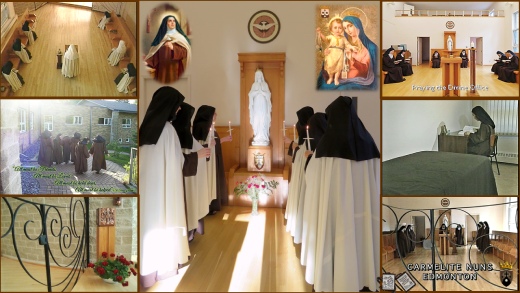Discalced Carmelite Nuns of the Order of the Blessed Virgin Mary of Mount Carmel

About Us
A Hidden Life of Prayer at the Service of the Church
The Discalced Carmelite Nuns are a Papally enclosed (cloistered) Order. Our contemplative life is dedicated to unceasing prayer for the sanctification of priests, the Church, and the world. Contemplative prayer is our “life work” and it is our service for the Church.
Mission
To be love and prayer in the heart of the Church is the mission and vocation of the Discalced Carmelite Nuns. The heart of a Carmelite embraces the whole world.
The contemplative life of Carmel has thriven in the Church since the 12th Century on Mount Carmel in the Holy Land where groups of hermits lived together a life of silence, solitude, work, and fraternal charity. From the beginning, these hermits had a special devotion to Our Lady, and the official title given to them in the Primitive Rule of the Order (in 1209) was the Order of the Blessed Virgin Mary of Mount Carmel. The prophet Elijah who was associated with Mount Carmel also inspired their way of life. Within fifty years of receiving their Rule, the Carmelites were forced to leave Mount Carmel because of political persecution and they settled in Europe.
The Carmelites needed reform in the 16th century and this was led by Saints Teresa of Avila (foundress) and Saint John of the Cross (co-founder). The reformed Order is known as the Discalced Carmelites.
The Discalced Carmelite Nuns from Macau, China founded our Carmel of St. Joseph in the
Archdiocese of Edmonton, Alberta in 1993. We settled in the beautiful rural area of Spruce Grove. The nuns are indeed fortunate when the monastery is situated amidst the beauty of Nature.
Charism
The heart of the Carmelite charism is prayer and contemplation. The life of a Carmelite is first and foremost a life of continual prayer which Saint Teresa defined as “friendship with God” or more exactly, “falling in love with Christ, frequently conversing alone with the One we know loves us.” Love is everything. Not romantic love, but love that sacrifices-that gives as Jesus gave. To live the Carmelite vocation one must develop a strong personal relationship with Jesus. Prayer, according to St. Teresa, “is a Person, not a method.”
For a Carmelite, prayer is guided by the teachings and experience of St. Teresa of Avila and St. John of the Cross. Those who aspire to join the Order study its spirit and life through the works of its greatest teachers, St. Teresa of Avila, St. John of the Cross, and St. Therese of Lisieux, all doctors of the universal Church.
The Carmelite life is for others. The very nature of the Teresian charism demands that the prayer of the Discalced Carmelite and the consecration of all her energies be directed towards the salvation of souls (Constitutions Nos. 4, 8, 10).
True to the ideal of our Holy Mother, Saint Teresa of Avila, we live our contemplative ecclesial life in an atmosphere that integrates, on the one hand, silence and “inhabited” solitude, with a sisterly communion of life, on the other. This is lived in a family that is set up like the little college of Christ centered on love for the Lord, and ruled by evangelical self-denial and sisterly charity in which, “all must be friends, all must be helped, all must be served, and all must be helped” (Way of Perfection, St. Teresa of Avila). In reforming the Order, St. Teresa achieved a perfect balance between these different elements: the hermit life and a life in community- a contemplative life wholly dedicated to the service of the Church in apostolic zeal. This Teresian balance of solitude and community living is characteristic of our charism and distinguishes it from all other Orders in the Church.
Carmel is totally Marian. The Order of Carmel is the Order of the Blessed Virgin Mary. Devotion to her is another characteristic of our Carmelite life and is symbolized by wearing the Brown Scapular, which is seen as a sign of belonging to the Order or being affiliated with it spiritually. The scapular signifies Mary’s maternal protection and also our commitment to following her Son and to be like Mary, who is the perfect model of contemplative prayer. In her spirit we strive to live, modeling our lives on her total surrender and loving union with God.
“The fate of humanity is decided by the prayerful hearts and uplifted hands of contemplative women.”
(Vultum Dei quaerere)

